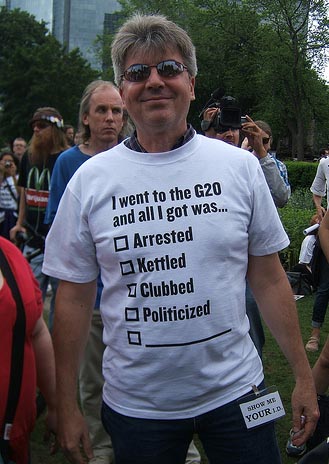On June 26, 2010, thousands of people witnessed thousands of police officers march upon, arbitrarily arrest, and injure protesters who had gathered at Queen’s Park in Toronto to voice their opposition to the G20 summit taking place nearby.
And a year later, on June 25, 2011, just feet from where dozens of protesters were corralled and run over by police horses, hundreds gathered to reinforce the call for an independent public inquiry into the events that surrounded the G20.
“This city has been wounded and we need a process of truth-finding so that we can heal,” said Nathalie DesRosiers, General Counsel of the Canadian Civil Liberties Association. “We need to do this for the strength of our democracy.”
G20 Redux, billed as a festival for civil liberties, gathered a diverse crowd, united in their outrage for the police brutality and attack on human rights that marked the weekend of the G20.
While individual demands from people present were diverse, the call for an investigation resonated throughout. Speakers from the Movement Defence Committee, the Ontario Federation of Labour and the Canadian Federation of Students reinforced these calls, and reminded people in attendance about the need to continue to fight against attempts to criminalize dissent.
“We were out on the streets for diverse reasons,” said Gilary Massa, the emcee for the rally. “I saw the brutality that was happening on peaceful protesters who were there to shed light on the variety of issues that were being met about by the G20 leaders.”
Massa also questioned the legitimacy of the G20, especially in light of police behaviour.
“The G20 is an illegitimate body that doesn’t represent its people, and our tax dollars were put toward brutalizing the citizens of Toronto. We want some answers, we want the truth to come out and we want Harper to take responsibility,” she said.
“We need to know who was behind this,” said Yutaka Dirks of the Movement Defence Committee. He added that the violence displayed during the G20 can be seen regularly in many communities in Toronto: “We don’t need an inquiry to learn why police acted the way that they did because it’s the same police in Jane and Finch and St. Jamestown harassing and policing people there.”
Some of the speakers were directly affected by police brutality during the G20.
John Pruyn had his prosthetic leg violently removed by police while protesting at Queen’s Park, the weekend’s so-called designated protest zone.
“My left leg was ripped off, my glasses were in my mouth. Police ordered me to hop and I responded ‘I can’t'” Pruyn yelled to the crowd. “They said ‘you asked for it’ and dragged me away,” he added.
Pruyn remained in the makeshift detention centre until around 10 p.m. the day after. To this day, Toronto Police have been unable to locate Pruyn’s canes, glasses, a whistle and the $33 he had with him.
“I never received an explanation of what happened,” Pruyn said.
“When they say that we should have stayed home,” said Brigitte DePape, “They want us to forget that the power of the people in the streets is greater than any government.”
DePape is best known as the “rogue page” who was fired from the Senate after she revealed a red stop sign placard on the floor of the Senate chamber during the Throne speech on June 3 that said “Stop Harper.”
“When we think outside of the ballot box, the possibilities for resistance and action are endless,” said DePape.
Author and rabble.ca blogger Judy Rebick also spoke, and focused on the need to hold the federal government accountable in addition to Toronto police leadership.
“We had window-breaking and cop car burning in Vancouver… six cars burned, a hell of a lot more windows broken and there were more injuries, and only 100 people were arrested,” said Rebick.
“[In Toronto there was] less damage, no attack on persons at all, no violence. People who were arrested are political prisoners arrested for political reasons,” she added.
Ninety per cent of the charges laid against more then 1,100 protesters have been dropped.
Participant Alexandra Savva watched the protests and police response during the weekend of the G20 on TV from her home in Kitchener. Having just finished a year of high school, Savva watched as she saw protesters dominate television coverage.
While she didn’t see the police brutality in the TV coverage she watched, she “saw that on YouTube.”
Savva, who will start university at Wilfrid Laurier in the fall, came with her sister to G20 Redux. Savva’s sister Amalia was present at the rallies last year. “It was disgusting and disturbing that they had their freedom and rights taken away,” she said.
G20 Redux was conceived as a festival with no march planned. After the program ended, more than 100 people gathered at the south end of the Queen’s Park lawn. After a short, impromptu performance by Test Their Logik, the crowd marched onto Queen’s Park circle and wound through Toronto’s streets.
The rally made several pauses on its walk, stopping at Queen and Spadina where several speeches were made. This intersection was the site of the infamous police kettling where people were held for hours in the pouring rain.
The rally snaked its way through Toronto’s streets tracing back to Yonge Street and eventually ended in front of the Toronto Police headquarters.
The police presence during the rally was remarkably smaller than one year earlier. Where thousands of police were used to clamp down on protesters, only five Toronto Police officers and four Queen’s Park security officers stood out front of the Legislature.
A call to Toronto Police seeking comment on G20 Redux was not answered.
Nora Loreto is a Toronto-based journalist.



